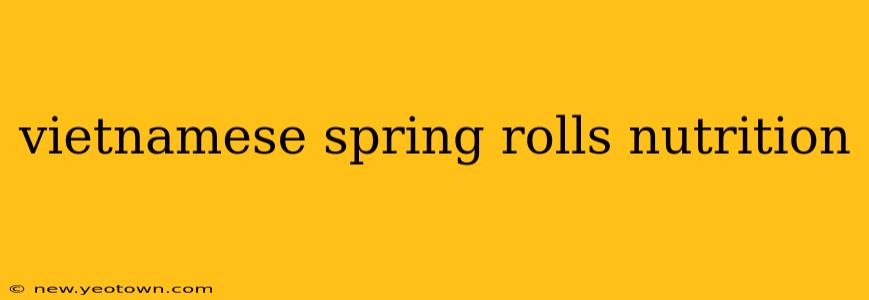Ah, the magic of a fresh Vietnamese spring roll! That delightful crunch, the explosion of vibrant flavors, the satisfyingly healthy feeling afterwards… it's no wonder these little bundles of goodness are a global favorite. But beyond the deliciousness, what's the nutritional story behind these iconic rolls? Let's dive in.
What are Vietnamese Spring Rolls Made Of?
The beauty of a Vietnamese spring roll (also known as gỏi cuốn) lies in its simplicity and versatility. At its heart, you'll find rice paper wrappers, translucent and delicate, encasing a vibrant mix of ingredients. These typically include:
- Rice vermicelli noodles: A source of carbohydrates for energy.
- Fresh herbs: Mint, cilantro, basil – these contribute essential vitamins, minerals, and antioxidants, adding a refreshing zing.
- Vegetables: Shredded carrots, cucumber, lettuce – providing fiber, vitamins, and a satisfying crunch.
- Protein: Often shrimp, pork, or tofu, adding protein for satiety and muscle building. Vegetarian versions are incredibly common and just as delicious!
- Peanut sauce (optional): While not a core ingredient, the creamy peanut sauce often served alongside adds a rich flavor and healthy fats (though it also contributes to the calorie count).
How Many Calories are in a Vietnamese Spring Roll?
The calorie count can vary dramatically depending on the ingredients and the size of the roll. A spring roll primarily filled with vegetables and a small amount of protein might clock in around 100-150 calories. However, adding more protein, heavier sauces, or larger portions can easily increase this to 200-300 calories per roll.
Are Vietnamese Spring Rolls Healthy?
Yes, generally speaking, Vietnamese spring rolls are a healthy choice, especially when compared to many other appetizers or snacks. They're low in saturated fat and cholesterol, and packed with vitamins, minerals, and fiber from the fresh produce. The rice paper wrappers themselves are relatively low in calories and offer a good source of carbohydrates.
However, the health benefits hinge heavily on the ingredients chosen. A spring roll loaded with fried meats or heavy sauces will naturally be less healthy than one filled with fresh vegetables and lean protein.
What are the Benefits of Eating Vietnamese Spring Rolls?
The nutritional benefits of Vietnamese spring rolls are numerous:
- High in Vitamins and Minerals: The abundance of fresh herbs and vegetables provides a wealth of vitamins A, C, and K, as well as essential minerals.
- Good Source of Fiber: The vegetables and noodles contribute to your daily fiber intake, aiding digestion and promoting gut health.
- Lean Protein Source: Depending on the filling, spring rolls can be a good source of lean protein, important for building and repairing tissues.
- Low in Fat: When made with lean protein and minimal sauce, spring rolls are relatively low in fat.
- Hydrating: The high water content of the vegetables and herbs contributes to hydration.
Are Vietnamese Spring Rolls Gluten-Free?
Typically, yes! Rice paper wrappers are naturally gluten-free, making them a suitable choice for those with celiac disease or gluten sensitivity. However, always double-check the ingredients list of the specific brand you're using to ensure there's no cross-contamination.
How to Make Vietnamese Spring Rolls Healthier?
To maximize the health benefits of your Vietnamese spring rolls, consider these tips:
- Load up on veggies: Prioritize vegetables and herbs over heavier ingredients.
- Choose lean protein: Opt for grilled chicken, shrimp, tofu, or even leave it out for a completely vegetarian option.
- Go easy on the sauce: Use peanut sauce sparingly, or consider lighter alternatives like a simple vinaigrette.
- Make your own: This gives you complete control over the ingredients and portion sizes.
Vietnamese spring rolls are a delicious and versatile dish that can be a healthy and nutritious part of a balanced diet. By being mindful of the ingredients, you can enjoy these tasty treats while reaping the rewards of their nutritional benefits.

